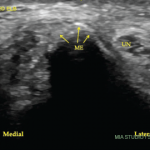Importance of the Physical Exam
Dr. Seo says there are only few situations in which he can get a clinical diagnosis based on a lab test, particularly if the patient’s history and physical presentation are not typical. Buttressing test results with the valuable information gleaned from a physical examination is key.
“When I am seeing a patient who has both neurologic and extra-neurologic problems, I cheat. I use the patient’s rash or joint pain or lung infiltrates as a guide to determining if their neurologic disease is also being adequately treated,” he says.
Example: When patients have only neurologic manifestations, such as in Susac’s syndrome, Dr. Seo wants a neurologist to “please pick up the phone and walk me through why you think I need to prescribe cyclophosphamide.” Something that might be an obvious conclusion to a neurologist, may not be as obvious to me. I may be more reluctant to augment immunosuppressive therapy, [because] I have developed a healthy respect for all of the complications associated with these drugs.”
Nerve Conduction Studies Can Be Operator Dependent
Neurologists should not be offended when rheumatologists question certain decisions. Dr. Seo says, “Nerve conduction studies are not perfect tests, inflammatory myopathy can be patchy and hard to find with blind biopsies, and the yield of sural nerve biopsy for vasculitic neuropathy is low. Even with tests that should be giving us definitive answers, there is often room for interpretation and doubt.”
Dr. Seo adds, “Knowing this, please don’t be insulted if I ask you to reconsider a diagnosis that doesn’t seem likely to you.”
Focus on Atypical Diseases
Dr. Seo notes that both specialties focus on the “business of evaluating patients with rare diseases.” But practicing rheumatologists must be wary when a neurologist says that because other options have been ruled out, a patient “must have a rheumatic disease.”
“When a rheumatic disease is a diagnosis of exclusion, it is helpful to communicate directly with the treating rheumatologist to ensure we’re all on the same page,” he says. “I largely diagnose rheumatic diseases based on pattern recognition. So when a patient doesn’t look like the last 10 patients I have evaluated with the same condition, I will want to triple check that every other cause has been excluded before I start immunosuppression. It’s the great irony of these conditions that the mimics of rheumatic disease, such as infection and malignancy, often worsen with immunosuppression, and once treatment begins, diagnostic tests become less reliable. So I’m generally reluctant to start aggressive immunosuppression empirically.



